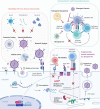Current strategies to circumvent the antiviral immunity to optimize cancer virotherapy
- PMID: 33795384
- PMCID: PMC8021759
- DOI: 10.1136/jitc-2020-002086
Current strategies to circumvent the antiviral immunity to optimize cancer virotherapy
Abstract
Cancer virotherapy is a paradigm-shifting treatment modality based on virus-mediated oncolysis and subsequent antitumor immune responses. Clinical trials of currently available virotherapies showed that robust antitumor immunity characterizes the remarkable and long-term responses observed in a subset of patients. These data suggest that future therapies should incorporate strategies to maximize the immunotherapeutic potential of oncolytic viruses. In this review, we highlight the recent evidence that the antiviral immunity of the patients may limit the immunotherapeutic potential of oncolytic viruses and summarize the most relevant approaches to strategically redirect the immune response away from the viruses and toward tumors to heighten the clinical impact of viro-immunotherapy platforms.
Keywords: central nervous system neoplasms; immunotherapy; oncolytic virotherapy; oncolytic viruses.
© Author(s) (or their employer(s)) 2021. Re-use permitted under CC BY-NC. No commercial re-use. See rights and permissions. Published by BMJ.
Conflict of interest statement
Competing interests: FL, JF and CG-M are reporting ownership interest (including patents). CG-M and JF are consultants and shareholders of DNATrix.
Figures

Similar articles
-
Oncolytic viruses and immunity.Curr Opin Immunol. 2018 Apr;51:83-90. doi: 10.1016/j.coi.2018.03.008. Epub 2018 Mar 16. Curr Opin Immunol. 2018. PMID: 29550660 Free PMC article. Review.
-
Integrating oncolytic viruses in combination cancer immunotherapy.Nat Rev Immunol. 2018 Aug;18(8):498-513. doi: 10.1038/s41577-018-0014-6. Nat Rev Immunol. 2018. PMID: 29743717 Review.
-
Immunomodulation in Oncolytic Measles Virotherapy.Methods Mol Biol. 2020;2058:111-126. doi: 10.1007/978-1-4939-9794-7_7. Methods Mol Biol. 2020. PMID: 31486034
-
The evolving landscape of oncolytic virus immunotherapy: combinatorial strategies and novel engineering approaches.Med Oncol. 2025 May 2;42(6):190. doi: 10.1007/s12032-025-02746-w. Med Oncol. 2025. PMID: 40314865 Review.
-
[The impact of innate immune response on the efficacy of oncolytic viruses].Vopr Virusol. 2024 Dec 15;69(6):479-488. doi: 10.36233/0507-4088-275. Vopr Virusol. 2024. PMID: 39841413 Review. Russian.
Cited by
-
Defects in intratumoral arginine metabolism attenuate the replication and therapeutic efficacy of oncolytic myxoma virus.J Immunother Cancer. 2023 Jun;11(6):e006388. doi: 10.1136/jitc-2022-006388. J Immunother Cancer. 2023. PMID: 37270180 Free PMC article.
-
An Engineered Influenza a Virus Expressing the Co-Stimulator OX40L as an Oncolytic Agent Against Hepatocellular Carcinoma.J Hepatocell Carcinoma. 2024 Jan 9;11:1-13. doi: 10.2147/JHC.S410703. eCollection 2024. J Hepatocell Carcinoma. 2024. PMID: 38223555 Free PMC article.
-
Phase I/II study of PexaVec in combination with immune checkpoint inhibition in refractory metastatic colorectal cancer.J Immunother Cancer. 2023 Feb;11(2):e005640. doi: 10.1136/jitc-2022-005640. J Immunother Cancer. 2023. PMID: 36754451 Free PMC article. Clinical Trial.
-
Targeted Suicide Gene Therapy with Retroviral Replicating Vectors for Experimental Canine Cancers.Int J Mol Sci. 2024 Feb 24;25(5):2657. doi: 10.3390/ijms25052657. Int J Mol Sci. 2024. PMID: 38473904 Free PMC article.
-
Therapeutic Implementation of Oncolytic Viruses for Cancer Immunotherapy: Review of Challenges and Current Clinical Trials.J Biomed Sci Res. 2022;4(2):164. doi: 10.36266/JBSR/164. Epub 2022 Oct 20. J Biomed Sci Res. 2022. PMID: 36381110 Free PMC article.
References
Publication types
MeSH terms
Grants and funding
LinkOut - more resources
Full Text Sources
Other Literature Sources
Medical
